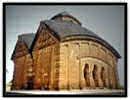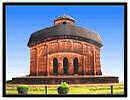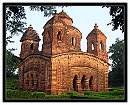
|
|

In the little-known village of Vishnupur, 200 km from Calcutta are the terracotta temples built by Malla rulers between the 7th and the 18th centuries. It is also the centre for tussar silks and ethnic symbols like the Bankura horse.
Vishnupur, the seat of power of the Malla dynasty who ruled over a large part of Bengal for nearly a thousand years before the British came. The Mallas ruled till the advent of the Muslims and relics of their reign survive till today.

Among the later Hindu kings of Bengal, the Malla occupy a place of distinction not only or their military prowess but because of their patronage to the development of distinctive styles of arts, architecture, sculpture, and music. During the reign of Veer Hambir and Raja Raghunath Singh and Veer Singh, Vishnupur became one of the principal centers of culture in Bengal.
The distinct style of temple architecture with a single tower resting on a square building with the curved roof of a Bengali hut has been the most characteristic feature of Vishnupur temples. Most of the temples here are in two big concentrations- the Shyam Rai, Jore Bangla, Radha Shyam, Lalji, Krishna Balram, Nikunja Bihari, and Kesari Rai within the fort area and the Kalachand, Radha Madhav, Radha Govinda, Jore Mandir, and Nandalal temples over an area to the South and South West of Lalbundh. The Malleswar, Madan Gopal and Madan Mohan temples are to the North of the fort. Besides, there is the Ras Mancha, the earliest extant religious edifice at Vishnupur built by Veer Hambir, representing an architectural style all its own.
There are a number of ‘bundhs’ or water reservoirs, namely, Lalbundh, Krishnabundh, Shyambundh etc. A number of cannons are there, exposed to weather for centuries and yet free from rust. One of these is ‘Dal Madal’.
Vishnupur developed a distinct style of music, i.e. Vishnupur Gharana of which perhaps the most famous exponent was Jadu Bhatta.
![]() Gum Ghar
Gum Ghar
![]() Shyam Rai
Shyam Rai
![]() Jore Mandir
Jore Mandir
![]() Jore Bangla
Jore Bangla
![]() Radha Shyam
Radha Shyam
![]() Kalachand
Kalachand
![]() Radha Madhav
Radha Madhav
![]() Garh Darwaja
Garh Darwaja
![]() Malleswar
Malleswar
![]() Madan Gopal
Madan Gopal
![]() Rashmancha
Rashmancha
![]() Dalmadal Cannon
Dalmadal Cannon
![]() Sanreswar Temple
Sanreswar Temple
![]() Jogesh Chandra Pura Kirti Bhavan Museum
Jogesh Chandra Pura Kirti Bhavan Museum
Connected by road and rail with Calcutta. 201 km by rail and 152km by road from Calcutta to Vishnupur.
By rail: By rail directly from Calcutta (201 km) on the southeastern section.
By Road: There are regular buses from Calcutta run by the Calcutta State Transport and the South Bengal State Transport Corporation.
Local handicrafts of Vishnupur includes silk, Tussar, conch shell wares, bell metal wares. Vishnupur is famous for terracotta toys and dolls, especially the stylized horses, better known as ‘Bankura Horses’. Vishnupur now is the center of production for the famous Baluchari saris that originated near Murshidabad. _More_
There is a tourist lodge run by the West Bengal Tourist Development Corporation; besides, there are a few private hotels. Also a lodge under the Vishnupur Municipal corporation.
Write Articles on various subject and news items for Bankura.Org. Translate from Bengali to english.
Temples built by King Raghunath Singha in between 1643
A.D. to 1660 A.D. : |
|||
| Gokulnagar: Gokulchand | -1643 A.D. by Raghunath Singha Or Chandra Malla | -Laterite | Pancharatna |
| Balsi: Lakhshminarayan | -1652 A.D. by Malla dynasty king of Jamkuri | -Laterite | Aatchaalaa |
| Bikrampur: Gopaljiu | -1659 A.D. by Raghunath Singha I | -Laterite | Deul w Jagamohan |
| Baital: Jhagrai Chandi | -1659 A.D. by Raghunath Singha I | -Laterite | Deul |
| Baital: Shyamchand | -1660 A.D. by Raghunath Singha I | -Laterite | Pancharatna |
| Yadavnagar: Yadavarai | -1650 A.D. by Raghunath Singha I | -Laterite | Ekratna |








